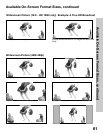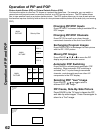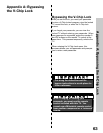
56
57
AUDIO/VIDEO Setting Descriptions: Video
Video Settings
A compressed (non-HD) video signal may cause
what appears to be a “blurry”, “out of focus”
or “fuzzy “ picture on a widescreen TV. This is
not a malfunction of the TV, but a result of the
compressed signal that is sent by cable or satellite.
To re-adjust the picture, try the following:
• Adjust your video settings (specifically
sharpness) for optimal picture performance.
• Use the Convergence Menu (page 53) to
properly align the TV.
• Change the format size (pages 60-61).
Contrast
Provides a slider to adjust the white-to-black
level. Low contrast shows a variety of shades
in darker images, while high contrast shows
darker images more uniformly black and makes
colors appear more vibrant.
Brightness
Provides a slider to adjust the overall
brightness of the picture.
Sharpness
Provides a slider to adjust the detail and clarity.
Color
Provides a slider to adjust the color intensity.
Tint
Provides a slider to adjust the proportion of red
to green.
Color Temp (Color Temperature)
Allows you to adjust how white images
are displayed. Your choices are:
• Low 6500K or Low (for DTV): White
images will have a warm cast to them. This
adjustment is an average and can vary due to
ambient room lighting, video scene brightness
and the TV’s age. The Low 6500K represents
the 6500K industry standard for NTSC (non-
DTV) pictures.
• Medium: White images will be balanced
between the Low (warm) and High (cool)
settings.
• High: White images will have a cool cast
to them. This setting may provide the most
realistic picture under bright lighting.
Video Noise
Reduces minor noise (graininess) in the
broadcast or input signal.
This function operates only in 480i mode.
Film Mode (Automatic)
Video media uses a video camera created
at 30 frames per second. Film media uses a
film camera created at 24 frames per second.
Examples of video media are live TV broadcast
such as news, special events, or video taped
programs. Examples of film media are motion
pictures, made-for-TV movies, and many prime
time programs. Filmed media is converted by
the broadcaster or home video company to
30 frames per second to match TV or video
standards. This conversion can leave subtle
“picture artifacts” or conversion errors.
The settings are On and Off. If you select On,
the system automatically detects if the signal
source is Film and corrects for conversion
errors. If you select Off, the system will never
correct for conversion errors.
This function operates only in 480i mode.
Note: A slider will display on-screen for each
setting. The slider has a numeric value, where
63 is the maximum, the mid-range is 31 and the
minimum setting is 0.
Note: For optimal picture performance, it is
recommended that you adjust your video settings
(specifically contrast and brightness) during initial
setup. Certain factors will affect your personal
preferences, including room lighting, glare
reflections and viewing angles/distance. This also
slows phosphor aging. If glare or reflections affect
your viewing on a continual basis, you may want to
remove the Diamond Shield (please refer to page
69).
AUDIO/VIDEO Setting Descriptions: Video


















